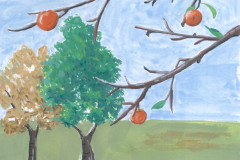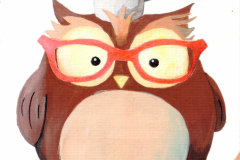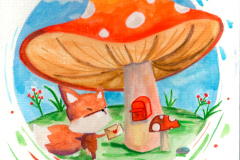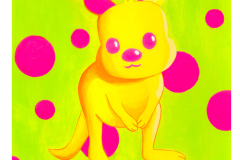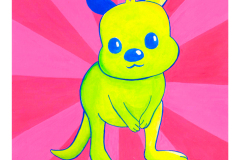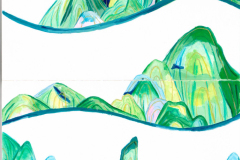Introduction
Fruit painting with gouache offers a unique way to create vibrant and eye-catching art pieces for your tabletop. Gouache, a water-based opaque paint, allows you to produce bright and bold colors that make fruits look delicious and fresh in your artwork. This medium is particularly suitable for fruit painting because of its ability to cover surfaces well and its quick-drying properties. If you want to add personal charm and color to your tabletop décor, exploring gouache fruit paintings is a rewarding experience.
In this article, you will learn practical techniques and ideas to create stunning fruit paintings using gouache. Whether you are a beginner or have some painting experience, these inspirations will guide you toward making beautiful artwork that fits perfectly on any tabletop. You will discover tips on selecting fruits, mastering gouache techniques, composing your artwork, and even maintaining your painted pieces. Let’s begin to brighten your space with colorful, delicious fruit paintings made with gouache.
Understanding Gouache Paint and Its Benefits for Fruit Painting
Gouache paint is a water-based medium that combines pigment, water, and a binding agent usually made from gum arabic. Unlike watercolor, gouache has fine particles that create a thicker and more opaque finish. This opacity allows you to layer colors without worrying about the underlying paint showing through, which is perfect for creating the rich textures seen in fruit paintings.
The quick drying nature of gouache helps when you want to build up bold shapes and vibrant colors rapidly. You can easily fix mistakes or add highlights by painting over dried layers. Compared to acrylics, gouache remains rewettable even after drying, which gives you flexibility during a session.
Using gouache for fruit paintings lets you highlight the shine on an apple or the soft fuzz on a peach with crisp, dense color. When you look at tabletop art, these qualities make your work stand out with clean edges and vivid hues that draw the eye.
Characteristics of Gouache Paint
Gouache has a smooth, matte texture that feels different from both watercolor and acrylic. Its opacity is one of its defining features—colors lay solid and bright, even on dark paper. This quality offers you control over fine details, like the veins of a leaf or the subtle curves of a lemon.
Drying time for gouache is relatively short, usually just a few minutes. This speed means you don’t have to wait long before adding new layers or details. Because the paint dries flat and uniform, it helps your fruit shapes stay bold, clean, and easy to see from a distance.
You might find it easier to correct or modify your work since the paint can be reactivated with water. This makes gouache friendly for detailed work and bold designs. If you want to create a painting that pops on your tabletop, these traits make it a strong choice.
Comparing Gouache with Other Paint Types
Watercolor offers a translucent finish, showing layers and paper texture beneath. It works well for light, delicate fruit paintings but may struggle with strong, opaque color blocks. Acrylic paint dries harder and is permanent once dry, providing a glossy finish but less ease for changes.
Gouache sits between these two. It shares the water-solubility of watercolor but adds the opacity and vibrancy of acrylics. For fruit painting, gouache lets you capture both soft gradients and sharp, defined shapes.
When you create tabletop art, the choice depends on your style. Do you want subtle washes or bold patches of color? Gouache offers quick drying and rich colors, which are ideal if you want bright, approachable artwork that can be adjusted as you paint.
Selecting Fruits for Your Gouache Paintings
Choosing the right fruits shapes the outcome of your gouache painting. Think about the forms and how they fit together on your canvas. Round oranges contrast well with the elongated shape of bananas. Triangular pineapple leaves add sharp angles, offering variety in your composition. Consider texture too; the rough skin of a kiwi can make your painting more engaging next to the smooth surface of grapes.
Popular fruits like apples, lemons, and strawberries often appear in paintings because of their simple shapes and vivid colors. Mixing these with less common options can refresh your work. Have you ever thought about how the bumpy exterior of a rambutan might offer new visual interest? Including unusual fruits often pushes your creativity further and can surprise viewers of your art.
Choosing Fruits Based on Color and Shape
Colors draw the eye, so select fruits that bring a balance of tones and contrasts. Bright reds of cherries jump off the page alongside the deep purple of plums. Shapes also affect how your painting flows; round, oval, and irregular forms create rhythm. Try grouping fruits with complementary colors and varying sizes to make your composition dynamic and lively.
Ask yourself which shapes feel natural to paint and which challenge your skills. Experiment with fruits that have unexpected shapes, like star fruit or figs, to add complexity. Using a variety of colors and shapes helps you avoid monotony and encourages more creative layering and detailing in your gouache work.
Incorporating Seasonal and Exotic Fruits
Seasonal fruits reflect the time of year, adding authenticity to your tabletop art. Painting ripe peaches in summer or bright pomegranates in fall captures the mood of each season. This approach motivates you to adjust your palette and technique. Seasonal changes can make your work feel fresh and relevant.
Exotic fruits introduce new textures, colors, and shapes uncommon in everyday scenes. Dragon fruit’s striking pink skin and white speckled inside create a bold statement. Mangosteen or passion fruit offer unfamiliar forms that inspire experimentation. Including these can set your fruit paintings apart and push you to try new creative directions. What seasonal or exotic fruit will you choose next?
Preparing Your Workspace and Materials for Gouache Painting
Setting up your painting area correctly helps you focus on capturing the fresh look of each fruit. Start with a clean, flat surface where you can spread out your items without clutter. Choose a space with good natural light or a daylight lamp to see your colors clearly. Keep a container of clean water nearby for rinsing brushes.
Protect your workspace with a plastic mat or old newspapers. Arrange your palette within easy reach along with paper towels for quick cleanups. Before painting, tape your paper to a rigid board to prevent warping from wet paint. This setup keeps your fruit paintings crisp and smooth.
Think about how you will handle drying time. Leaves some space to put your finished pieces aside while they dry. Can your workspace stay organized while you work on bright, layered fruit shapes? Setting up this way helps you focus on details and colors without distraction.
Essential Materials for Gouache Painting
Select a set of round and flat synthetic brushes in small to medium sizes—sizes 4, 6, and 8 work best for fruit details and filling shapes. Choose gouache paints that have strong pigments and good lightfastness to keep colors vibrant over time.
Pick heavyweight watercolor paper or smooth mixed media pads that resist buckling. Use a plastic or ceramic palette with wells for mixing colors. Keep old brushes or sponges ready for texture effects. Have a spray bottle close by to rewet dried paint when blending.
Don’t forget a pencil for sketching your fruit outlines lightly. A color wheel may help you plan contrasts and highlights. How does your choice of materials influence your control over fine fruit textures or juicy shine?
Organizing Your Workspace for Efficiency
Arrange brushes in containers, separating clean and used ones. Place your gouache tubes or pans in the order you use most, such as reds, yellows, greens, and blues. Keep mixing palettes at the center for easy reach during layering or blending.
Position your water jars off to one side to avoid spills but close enough for frequent rinsing. Use a small towel or cloth nearby to dry brushes quickly. Store reference photos or actual fruit where you can clearly see them without moving too much.
Arrange materials so your dominant hand can grab what you need without crossing over the paper. Regularly tidy your area mid-session to maintain focus. How might adjusting your workspace improve your painting flow and reduce interruptions?
Basic Techniques for Painting Fruits with Gouache
Working with gouache offers a unique way to bring fruits to life on tabletop art. One of the key skills you will use is layering colors. Starting with a base color helps you build a solid foundation. Then, apply additional layers to add shadows and highlights. This process creates a rich, three-dimensional feel that makes the fruit look real and juicy.
Blending is another essential technique. Gouache dries quickly, so you have to work fast to mix colors smoothly on your paper. Use a damp brush to soften edges between colors, helping you achieve subtle variations like the blush on an apple or the gradient on a pear.
Texture plays a vital role in making fruit appear tangible. You can create texture by using a dry brush with minimal paint to mimic the skin of oranges or the fuzz on peaches. Trying out different brush strokes and pressure will help you discover ways to reproduce each fruit’s unique surface.
Layering Colors to Achieve Depth
Start with light, flat layers to block in the fruit’s general shape and color. Each new layer should be slightly darker or more detailed. Think about where the light hits the fruit and where shadows fall. Apply those darker tones in thin washes. This slow build-up prevents colors from becoming muddy.
You can build layers using both transparent and opaque paint. Transparent layers allow some of the underpainting to show through. Opaque layers cover previous colors, adding boldness. Combining these creates a vibrant effect that feels full and deep.
Does your fruit look flat? Try adding a few subtle mid-tone layers before the darkest shadows. This gradual build-up increases realism and gives your painted fruit a more natural volume.
Blending and Texturing with Gouache
For smooth blends, use a clean, damp brush to soften color boundaries while the paint is still wet. You can blend two colors directly on your paper with small back-and-forth strokes. This works well for fruits with smooth skins like plums or grapes.
Creating texture involves layering thicker paint with a dry brush technique or using small dots and dabs. Use this to imitate textures like the tiny bumps on a strawberry or the rough peel of a lemon.
Try flicking paint with a stiff brush to create subtle speckles that resemble natural imperfections. These small details can make your artwork stand out. What kind of texture will you add to your fruit painting next? Experiment and see how different techniques transform your tabletop art.
Composing Your Fruit Painting for Tabletop Art
Creating a painting meant for tabletop use requires special attention to how the artwork fits the space. Think about the size of your table and the way people will view your painting. You want the composition to draw attention without overwhelming the setting.
Start by placing your main fruit near the center or slightly off-center to create a clear focal point. This focal point will guide the viewer’s eye and give the painting purpose. Consider the shapes and sizes of the fruits you include and arrange them so they support the central fruit, balancing the entire image.
Balance plays a big role in how your painting feels on a table. If one side is too crowded or busy, the painting can feel awkward. Try to spread visual weight evenly by mixing large and small fruits or using contrasting colors on each side. Ask yourself how your arrangement looks from different angles, as tabletop art often gets viewed all around. Will people want to lean in for a closer look? Can the setting handle bold or subtle layouts?
Creating a Balanced Composition
Place fruits of different sizes and shapes next to each other to avoid monotony. Group a few round fruits with elongated or irregular shapes to create visual interest. If you paint fruits with varied colors, distribute those colors evenly to avoid one side feeling heavier than the other.
Empty spaces in your painting matter. They give the eyes room to rest and highlight the fruits better. Think about the negative space as part of your overall design. How does spacing between fruits change the way your painting feels? Try sketching your layout before painting. Move objects around to see what arrangement feels right. These small adjustments help you create a composition that feels natural and balanced on your tabletop.
Focusing on Details to Enhance Tabletop Art
People will see your painting up close when it rests on a tabletop. Small details matter more in this setting compared to wall art. Focus on textures like the dimpled skin of an orange or the subtle shine on grapes. These details keep your painting engaging when viewed closely.
Use thin brushes to carefully capture veins on leaves or tiny imperfections on fruit surfaces. This level of detail adds realism and depth without overwhelming the whole composition. Ask yourself which details will make someone want to pick up your painting and look longer. Would the tiny seeds inside a sliced strawberry or the fuzz on a peach invite closer inspection? Adding these elements gives your tabletop fruit painting life and makes viewers feel connected to your work.
Adding Highlights and Shadows for Realism
Using gouache to paint fruit offers a unique chance to play with light and shadow to bring your artwork to life. Painting highlights makes fruit look fresh and juicy, while shadows add depth and volume, turning flat shapes into three-dimensional wonders on your tabletop.
Think about where your light source is positioned. This helps you decide where the brightest areas, or highlights, will appear. Highlights show the shiny skin or wet surface of fruit, making it look inviting and ripe. When you add shadows, you show where the fruit curves away from the light, giving it form and weight.
Have you noticed how a red apple isn’t just one shade? It has bright spots, mid-tones, and deep shadows—all captured with layers of gouache. You can use thin, light layers to build color and carefully blend edges between highlights and shadows. This practice helps your painting avoid a flat appearance and creates a lively, realistic fruit depiction for your tabletop art.
Applying Highlights Effectively
Highlights are the bright spots where light hits the fruit most directly. Use thick, opaque white or light-colored gouache to add these touches. Place highlights where the skin looks smoothest and reflective, such as the curved surface of an orange or the shiny tip of a cherry.
Try working with a small round brush for precise control. Dab the paint carefully, instead of brushing it on heavily. Remember, less is more—too much highlight can look unnatural. After the paint dries, you can glaze a touch of color over the highlight to blend it into the surrounding tones for a soft effect.
Ask yourself: does this highlight reveal freshness? Does it emphasize juiciness? Adjust accordingly to capture the appealing look of your fruit. Think about the time you last saw ripe fruit gleaming under a morning sun—your painting should reflect that feeling.
Creating Shadows to Add Dimension
Shadows give your fruit shape and weight. Begin with a base color for the fruit, then add darker tones where it curves away from the light. Use a slightly diluted mix of your base color combined with a complementary color to avoid pure black shadows, which can look harsh.
Layer shadows gradually with thin strokes of gouache, building up darkness in areas such as beneath the fruit, between clusters, or near stems. Soft edges make shadows appear natural, so blend carefully where light fades into dark.
Try varying your brush pressure and paint thickness to give shadows subtle texture. This approach helps your fruit sit firmly on the tabletop rather than floating. How can you use shadows to suggest the roundness or indentations in your fruit? Experiment and observe real fruit closely to answer this question in your painting.
Incorporating Backgrounds and Surroundings
Choosing the right background for your gouache fruit paintings can change how your artwork looks on your tabletop. The background should support the fruits while fitting the style of the table and room where it will be displayed. Think about the colors and shapes already around your table. Will a light or dark backdrop make your fruits pop? Could adding subtle shadows or surface textures give depth without stealing attention from your main subject?
If your tabletop has a busy pattern, a calm background in your painting helps balance the visual flow. On the other hand, a plain table could benefit from a bit of texture or simple patterns behind the fruit to bring the scene to life. Ask yourself what mood or theme your tabletop conveys and how your fruit painting can enhance it. Small choices like these create harmony and keep your tabletop art from feeling disconnected or out of place.
Simple Backgrounds for Focus on Fruit
Keeping backgrounds simple directs all the attention to your fruit. Opt for solid colors or gentle gradients. Soft washes of a single hue help your berries, apples, or citrus stand out clearly. These backgrounds avoid clutter and make details in your fruit the star of the painting.
Try painting a smooth pale blue or warm cream background behind rich reds and yellows. Use subtle transitions of color rather than patterns. Sometimes a few faint brush strokes that hint at a table surface or the air around fruit can add depth without distraction. Will your fruit work better against light or muted tones? This choice impacts how your viewers see the shapes and colors of your fruit directly.
Decorative Backgrounds to Match Tabletop Style
Use patterns and textures in the background that reflect your table’s character. If your tabletop is rustic wood, add thin lines or knots with your brush to echo that texture behind the fruit. For a sleek, modern table, geometric shapes or muted patterns can connect the painting to its surroundings.
Consider subtle polka dots, crosshatches, or light floral prints painted in soft colors behind your fruit. These touches create a relationship between your artwork and the physical table it sits on. Avoid overpowering details. Instead, let textures whisper their presence while fruit remains dominant.
How could a background pattern emphasize the style of your tabletop? Try matching color tones or repeating shapes found in table linens or nearby décor. This approach adds personality and ties your gouache fruit paintings firmly to the place you want them to brighten.
Sealing and Protecting Your Gouache Fruit Paintings
Gouache paintings on tabletops require special care to stay vibrant and intact. These surfaces face spills, heat, and frequent contact, which can impact your artwork. Protecting your gouache fruit painting means choosing the right sealing method and maintenance routine.
Sealing adds a protective layer that guards against scratches and moisture. Without it, even a small splash can cause color damage or smudging. Since gouache is water-based and sensitive to water after drying, sealing helps lock in those rich colors and smooth textures you worked hard to create.
Think about how you use your tabletop art. Is it a dining table, a side table, or a decorative piece? Understanding this helps decide the level of protection needed. Sealing your painting correctly keeps your artwork looking fresh, making it easier to enjoy your colorful tabletop for years.
Choosing the Right Sealant
Selecting a sealant designed for delicate, water-based paint makes a big difference. Spray varnishes labeled as “matte” or “satin” work well without changing the gouache’s soft look. Look for acrylic polymer varnishes that dry clear and provide a durable finish.
Acrylic spray varnish protects against moisture and dust without yellowing. Apply several thin coats, allowing each to dry fully to avoid cloudiness. Use a light touch when spraying to prevent disturbing your paint layers.
Brush-on varnishes give more control but require careful, gentle strokes to prevent lifting gouache. Water-based polyurethane can also protect against scratches but test it on a small area first to make sure it won’t alter colors.
Consider your tabletop use to decide which sealant fits best. Will your table hold hot dishes? A heat-resistant sealant can offer extra defense. Often, layering sealants creates stronger protection, but always test products to ensure compatibility.
Tips for Maintaining Your Artwork
Clean your sealed gouache paintings carefully with a soft, dry cloth. Avoid water and harsh cleaners to stop damage to the protective coating. If a spill occurs, wipe it up quickly without scrubbing.
Keep your painted tabletop away from direct sunlight to prevent fading. Regularly check for any signs of wear or peeling and reapply a sealant if needed.
Do you host frequent meals or projects on your tabletop? Using placemats or coasters over your painting gives an extra layer of protection that reduces direct contact.
Handle your artwork gently when moving or cleaning. Remember, even sealed, gouache requires respect to maintain its color and texture. Following these tips keeps your fruit paintings bright and beautiful on your tabletop for daily enjoyment.
Creative Ideas to Use Gouache Fruit Paintings on Tabletop Art
Fruit paintings bring a fresh and lively touch to your tabletop. You can use these paintings in many ways to brighten your dining or coffee table.
Try decorating trays with your gouache fruit art. Paint directly on wooden or metal trays to create unique serving pieces. Coasters are another perfect canvas. Their small size highlights the detail in fruit paintings and adds personality to your table.
Placemats featuring vibrant fruit designs also enhance mealtime. You can seal these with a protective finish to handle spills. Think about combining several pieces to form a fruit-themed tabletop setting. Using color and pattern thoughtfully will make the whole look cohesive and fun.
Which tabletop item do you think would brighten your space the most? Imagine how a small fruit painting could refresh an everyday object. Play with scale, layout, and color for your next tabletop project.
Painting Directly on Tabletop Surfaces
Paint your fruit designs straight on wood, glass, or metal tabletops for a lasting effect. Start by cleaning and sanding the surface for paint to grip well. Use a base coat to smooth the area and help colors pop.
Gouache requires a sealed and matte surface. After your design dries, seal it with clear varnish to protect against scratches and moisture. Work in thin layers to avoid cracking. Small fruit shapes or patterns work best for direct application.
Pay attention to the surface texture and durability. Wooden tables absorb more paint than metal or glass, changing how colors appear. Have you tested painting a tabletop before? Practicing on a sample helps you find the right approach.
Creating Removable Fruit-themed Art Pieces
Not every tabletop needs permanent fruit designs. Making framed fruit paintings or modular pieces lets you switch up décor easily. Use lightweight wood panels or thick paper for painting fruit with gouache.
Frame these pieces with glass or acrylic and place them on trays, under glass tabletops, or even lean them against walls near your table. Magnetic or Velcro strips can help attach removable art on metal or wooden surfaces.
This approach keeps your options open and lets you refresh your tabletop look on a whim. Think about creating a set of small fruit paintings that you can rearrange seasonally or for special occasions. What fruit designs would you frame first?
Inspiring Artists and Trends in Fruit Gouache Painting
Famous Fruit Paintings and Artists
Fruit has been a popular subject in art for centuries. Artists like Caravaggio and Paul Cézanne brought fruit to life with their paintings. Caravaggio’s “Basket of Fruit” captures fine detail, showing the texture and color of each piece. Cézanne focused on shapes and shades, using fruit to explore form and perspective. These paintings helped make fruit a symbol of everyday beauty in art. Taking inspiration from such artists can help you see fruit beyond its simple look. How can you capture the color and shape of fruit in your own gouache paintings? Study these masters to understand the balance between realism and creativity in fruit art.
Modern Trends in Gouache Fruit Art
Today, fruit paintings in gouache show a mix of styles. Some artists use bright, flat colors for a graphic look. Others blend soft layers to create lifelike textures. Many focus on close-up views, showing fruit slices or peeling skin in detail. Some artists add unusual backgrounds or combine fruit with abstract shapes to bring freshness to their work. You could try using gouache’s opaque qualities to layer bold colors or experiment with wet-on-wet for smooth blends. What happens when you pair realistic fruit shapes with unexpected colors? Trying new brush techniques or combining styles could give your tabletop art a unique touch. What fresh ideas will you bring to fruit gouache painting?
Conclusions
Creating gouache fruit paintings for tabletop art combines creativity with practical painting skills. Through selecting a variety of fruits and mastering gouache techniques, you can achieve vivid and textured results that stand out. These paintings not only enhance your décor but also offer a creative outlet that you can enjoy anytime. The opaque nature of gouache and its quick drying time allow you to layer colors, correct mistakes, and add details to highlight the texture and freshness of fruits.
Keep practicing and using different inspirations to refine your artwork. Think about the arrangement, color contrasts, and the table’s theme when adding your paintings to your tabletop. Remember, your fruit paintings can bring warmth and character to your space, making it welcoming and lively. With the ideas and tips provided here, you are well on your way to creating beautiful, delicious gouache fruit paintings for your tabletop art projects.





















